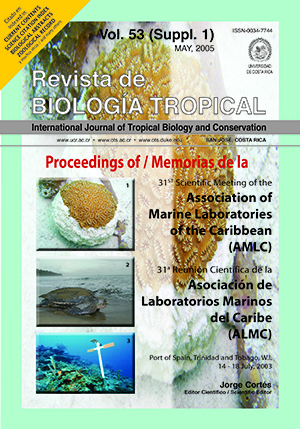Abstract
The use of chemical pesticides and herbicides has increased environmental pollution and affected ichthyofauna in the watersheds where they are used. We studied the effect of an herbicide, triazine, on the kidneys of two species (Caquetaia kraussii and Colossoma macropomum) widely found in Caribbean and South American rivers. In Venezuela, these species are abundant and have a high aquaculture potential because they may be cultured and reproduced in captivity. Four kidney samples from juveniles of each species exposed to the herbicide were examined by Transmission Electron Microscopy. Kidney tubule alterations included loss of plasmalemma and cell interdigitations, misshaped mitochondria, decrease in rough endoplasmic reticulum and free polysomes, and the presence of autophagic vacuoles and primary lysosomes. These alterations at the cellular level may explain fish behaviour in terms of kidney tubule pathology, and relative amounts and conditions of organelles within affected cells.References
Arisyoshi, T., S. Shiiba, H. Hasegawa & K. Arizono. 1990. Profile of metal binding proteins and heme oxygenase in red carp treated with heavy metals, pesticides and surfactants. Bull. Environ. Contam. Toxic. 44: 643-649.
Cooper, R.L. & R.J. Kaviock. 1997. Endocrine disruptors and reproductive development: a weight-of-evidence overview. J. Endocrin. 152: 159-166.
Denoyelles, F., W.D. Kettle, C.H. Fromm, M.F. Moffett & S.L. Dewey. 1989. Use of experimental ponds to assess the effects of a pesticide on the aquatic environment. Miscel. Publ. No. 75, 34th Ann. Meet. Entomol. Soc. Amer., Nov. 29 - Dec. 3, 1987. MPPEAL 75: 1-88.
Diana, S.G., W.J. Resetarits Jr., D.J. Schaeffer, K.B. Beckmen & V.R. Beasley. 2000. Effects of atrazine on amphibian growth and survival in artificial aquatic communities. Environ. Toxic. Chem. 19: 2961-2967.
Felsot, A.S. 2001. Herbicide tolerant genes, Part 4. Withering wildlife?. Agrichem. Environ. News 178: 1-8.
Gomez, L., J. Masot, S. Martínez, E. Durán, F. Soler & V. Roncero. 1998. Acute 2,4-D poisoning in tench. (Tinca tinca L.): Lesions in the haematopoietic portion of the kidney. Archiv. Environ. Contam. Toxic. 35: 479-483.
Gonzalez, J. & B. Heredia. 1998. El cultivo de la cachama (Colossoma macropomum). Maracay, Venezuela, FONAIAP. Centro de Investigaciones Agropecuarias del Estado Guárico. 134 p.
Hamm, J.T. & D.E. Hinton. 2000. The role of development and duration of exposure to the embryotoxicity of diazinon. Aquat. Toxic. 48: 403 418.
Hayes, T.B., A. Collins, M. Lee, M. Mendoza, N. Noriega, A.A. Stuart & A. Vonk. 2002. Hermaphroditic, demasculinized frogs after exposure to the herbicide atrazine at low ecologically relevant doses. Proc. Nat. Acad. Sci. (U.S.A.) 99: 5476-5480.
Larkin, D.J. & R.S. Tjeerdema. 2000. Fate and effects of diazinon. Review Environ. Contam. Toxic. 166: 49-82.
Lauren, D.J., A. Wishkovsky, J.M. Groff, R.P. Hedrick & D.E. Hinton. 1989. Toxicity and pharmacokinetics of the antibiotic fumagillin, in yearling rainbow trout (Salmo gairdneri). Toxic. App. Pharmac. 98: 444-453.
Medina, J. 1995. Informe de Gestión. FONAIAP. Estación Experimental Guárico. Sub-Estación Guanapito. 56 p.
Mallat, J., J.F. Bailey, S.J. Lampa, M.A. Evans & S. Brumbaugh. 1995. A fish gill system for quantifying the ultrastructural effects of environmental stressors: methylmercury, Kepone and heat schock. Canad. J. Fish. Aquat. Sci. 52: 1165-1182.
Powell, M.D., G.M. Wright & D.J. Speare. 1995. Morphological changes in rainbow trout (Oncorhynchus mykiss) gill epithelia following repeated intermittent exposure to chloramines T. Canad. J. Zool. 73: 154-165.
Rolf, L.L., M.D. Setser & J.L. Walker. 1986. Pharmacokinetics and tissues residues in chanel catfish, Ictalurus punctatus, given intracardiac and intramuscular injections of gentamicin sulphate. Vet. Hum. Toxic. 28 (Suppl 1): 25-31.
Segnini de Bravo M.I. & K.S. Chung. 2001 Ecophysiological Behavior of Caquetaia kraussi exposed to different temperatures and salinities. Rev. Biol. Trop. 49: 141-156.
Struger, J. & S. Painter. 1997. Endocrine disruptions in the great lakes basin: an assessment of agricultural and industrial inputs. Soc. Environ. Toxic. Chem. SETAC 18th Ann. Meet. Abstract Book. PWA140. Pp. 255.
Szarek, J., A. Siwicki, A. Andrzejewska, E. Terech-Majewska & T. Banaszkiewicz. 2000. Effect of herbicide roundup super TM on the structural pattern of hepatocytes in carp. Mar. Environ. Res. 50: 263-266.
Wester, P.W. & J.H. Canton. 1986. Histopathological study of Oryzias latipes (medaka) after long term β-hexachlorocyclohexane exposure. Aquat. Toxic. 9: 21-45.
Wester, P.W., J.H. Canton, A.A.J. van Lersel, E.I. Krajnc & H.A.M.G. Vaessen. 1990. The toxicity of bis(tris-n-butyltin)oxide (TBTO) and di-n-butyltindi-chloride (DBTC) in the small fish species Oryzias latipes (medaka) and Poecilia reticulata (guppy). Aquat. Toxic. 16: 53-72.
Wiegand, C., S. Pflugmacher, M. Giese, H. Frank & C. Steinberg. 2000. Uptake, toxicity and effects on detoxication enzymes of atrazine and trifluoroacetate in embryios of Zebrafish. Ecotox. Environ. Safety 45: 122-131.
Wiegand, C., E. Krause, C. Steinberg & S. Plugmacher. 2001. Toxicokinetics of atrazine in embryos of the zebrafish (Danio rerio). Ecotox. Environ. Safety 49: 199-205.
Comments

This work is licensed under a Creative Commons Attribution 4.0 International License.
Copyright (c) 2005 Revista de Biología Tropical






